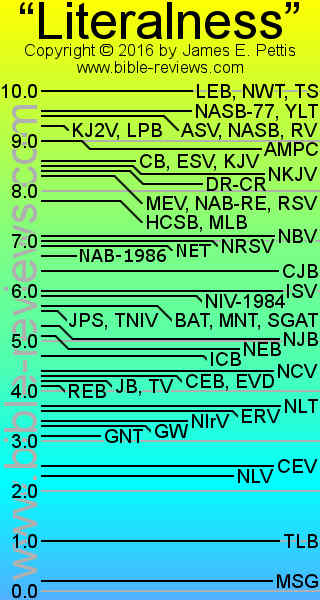Why Are There So Many Bible Versions?
Reason #5: Translation Methodology
Introduction
Translation Methodology is just a fancy way of saying, “the style (method) used when translating.” For the sake of brevity, in this page I describe the various translation methodologies only very briefly and then explain why the existence of multiple methodologies causes more English Bible translations to be produced. I plan to explain translation methodologies more fully on another page in the future.
Methodologies
I will consider two basic “sets” or ”ranges” of translation methodologies: “Literalness” (in quotes because it is an imprecise term) and Reading Level.
“Literalness”

A Bible translator can employ a word-for-word methodology (known as Formal Equivalence), a thought-for-thought methodology (known as Dynamic Equivalence), or any combination of those two. What may not be obvious is that there are pros and cons associated with each “literalness” methodology, A Bible translation that is the product of one methodology serves some purposes and some audiences best, while another methodology produces a Bible that serves another purpose or audience best.
In addition to those varieties we have paraphrase Bibles, which typically are not actually translations. A paraphrase Bible is actually the Bible rewritten. Usually the source text is an existing Bible translation in the same language as the paraphrase Bible. So: no actual translation involved.
Usually the purpose behind a paraphrase Bible is to make the Bible easier to read by changing its style. The Bible as it is written primarily has a style similar to a history textbook, which style many people find boring or difficult to read. Paraphrase Bibles typically have a writing style that is more similar to modern novels, and therefore are much easier to read for many people.
Reading Level

One of the characteristics a translator must consider is this: what is the reading level of the people who will be reading the translation?
Traditionally this was not considered and any translation would possess roughly the same reading level as the source document. However, in modern times — and in particular with regard to very popular works of literature such as the Bible — translators produce multiple translations with varying reading levels to serve readers of various ages and reading skill.
It so happens that the Bible contains several documents that have a fairly advanced reading level. Because of this, there are Bible translations at various reading levels, ranging from 3rd-grade reading level (NIrV) all the way to 11th-grade reading level (RSV) and even higher for archaic Bible versions. (The archaic language makes archaic Bibles more difficult to read than originally intended by the translators.)
Conclusion
- Should I use word-for-word, thought-for-thought, something in between, or paraphrase methodology?
- What reading level should my translation be?